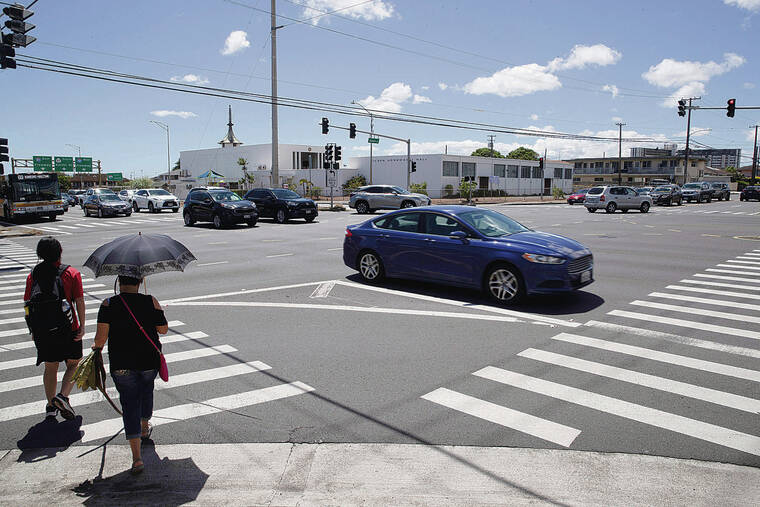Vandalism has further delayed the start of the state’s red-light camera ticketing program for 10 Honolulu intersections until at least November.
Someone climbed a utility pole at the intersection of School and Kalihi streets in May and damaged equipment that had been installed for an engineering study that the state Department of Transportation said would be used in determining which 10 intersections would get red-light cameras, the Honolulu Star-Advertiser has learned.
DOT officials had previously announced that the results of the engineering study would be posted online in March, then sometime this summer, and now, later this month.
In an email to the Star- Advertiser, DOT spokesperson Shelly Kunishige initially said, “Vandalism delayed the collection of the baseline data.” Asked how vandalism delayed the study, Kunishige later wrote, “Some of the equipment for the baseline data collection required by law was stolen.”
A state lawmaker said she was told by a DOT administrator that vandalism was indeed to blame.
State Sen. Lorraine Inouye, who served as chair of the Senate Transportation Committee when the red-light camera law was passed in 2020, told the Star-Advertiser, “It was actually not stolen. I would call it more like vandalism.
“Actually what happened was whoever tried to get onto it from a pole … they probably thought it was already in place with a camera, probably ran the light, and probably said, ‘I’m going to get rid of the cameras,’ but it was just the data collection.”
The DOT administrator who informed Inouye could not be reached for comment by deadline Thursday.
The end result, according to Kunishige, is that the red-light camera system at 10 yet-to-be-chosen intersections will begin issuing citations in November at the earliest.
Inouye said the vandal attempted to dismantle the system at the intersection of School and Kalihi streets on May 24 and damaged it enough to make its data irretrievable, prompting another round of data collection.
The equipment at other intersections had acquired data while school was in session, so to record comparable data, the contractors had to wait until school resumed to collect the missing data, further delaying the system’s activation, she said.
Separately, 10 hours of data was not retrievable from the equipment located at the intersection of Palama Street and Vineyard Boulevard, prompting another round of data collection after the original period, Inouye said. “I understand it is unclear whether this was due to an equipment malfunction or vandalism,” she said.
The vandalism incident should have been reported to the police since it involved a utility pole, Inouye said.
“The vendor found the equipment vandalized and reported to DOT Highways,” she said.
Kunishige confirmed that the contractor filed a report and referred the Star-Advertiser to the company for more information.
The contractor, Arizona- based Verra Mobility, did not respond to requests for comment, and the Honolulu Police Department could not verify whether a report had been filed.
The $2.5 million contract for the two-year pilot program was originally awarded to an Australian company, Redflex Traffic Systems, in May 2021. The company was purchased a month later by Verra Mobility.
In February, DOT officials said the goal of red-light cameras was to reduce traffic fatalities from motor vehicle crashes involving red-light running. The law creating the red-light camera system called for a study to find a baseline average of how many vehicles run red lights at prospective intersections.
Kunishige explained that once the engineering studies are posted, now slated for later this month, the 10 chosen intersections will be announced and an “education period” will begin to inform the public about the red-light cameras. Thirty days after the study’s posting, warnings will be issued for those who run red lights. Thirty days after that, now November, drivers will receive citations for running red lights, she said.
Supporters in the debate over the cameras consider them a deterrent against running red lights that makes streets safer, while detractors say they can increase rear-end accidents and can wrongly punish a vehicle’s owner if someone else was driving.
Inouye considers herself “a big supporter of this project.”
“We have too many dangerous intersections,” she said. “We have too many people that are not concentrating on driving, and that’s why we have so many incidents and accidents.”
Once installed, this will be Honolulu’s second go-round with a traffic-enforcement camera system.
The act creating the new red-light camera system referred to the photo-imaging system to detect speeding motorists which was implemented in January 2002 as having “generated intense public opposition.”
Then-Gov. Ben Cayetano permanently shut down the highly unpopular so-called van-cam program four months later after spending about $8 million on it.
“The public perceived that the program was operated more to maximize revenue for the vendor running the program than to improve traffic safety,” the act states.
This time around, officials say, fines will be deposited into a special fund that can be used by the DOT to establish, operate, manage and maintain the system.






